A Comprehensive Guide
If you’re seeking a comprehensive guide to red oak veneer, you’re in the right place.
With so many options, choosing the perfect veneer can be overwhelming.
This guide covers everything from types to applications, helping you make an informed decision for projects like veneered panels, furniture, cabinetry, wood doors, flooring, and decorative paneling.
Let’s dive in!
1. What is American red oak wood veneer?
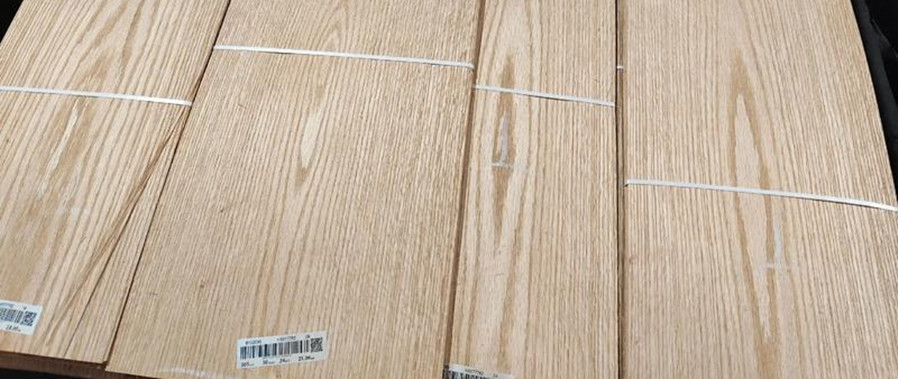
Before diving into the details of American red oak wood veneer, it’s important to understand exactly what it is.
Its Latin Name is Quercus rubra (Family: Fagaceae).
Red oak, native to North America, grows in warm, humid climates, typically in well-drained soils in mountains, hills, and forest edges.
With a density of 0.6-0.75 g/cm³, red oak offers good weight and workability, depending on moisture content and the growing environment.
2. How is American red oak wood veneer made?
The cutting method of veneer is the most important step in the production process.
2.1 Horizontal veneer slicer
A horizontal veneer slicer cuts thin wood slices from a log or block, with the blade moving horizontally across the wood.
It is ideal for producing thin veneer sheets with uniform thickness.
2.2 Half rotary slicer
A half rotary slicer is a machine used in the veneer production process, where the log is sliced into thin sheets with a rotating blade that moves in a half-rotating arc.
This method allows for the creation of unique grain patterns and is especially useful for cutting straight grains or patterns in wood veneer.
2.3 Vertical veneer slicer
A vertical veneer slicer cuts thin wood slices from a log with a vertically moving blade, producing thicker veneers (0.4mm+) and specific grain patterns like flat cut crown grain.
3. Types of American red oak wood veneer
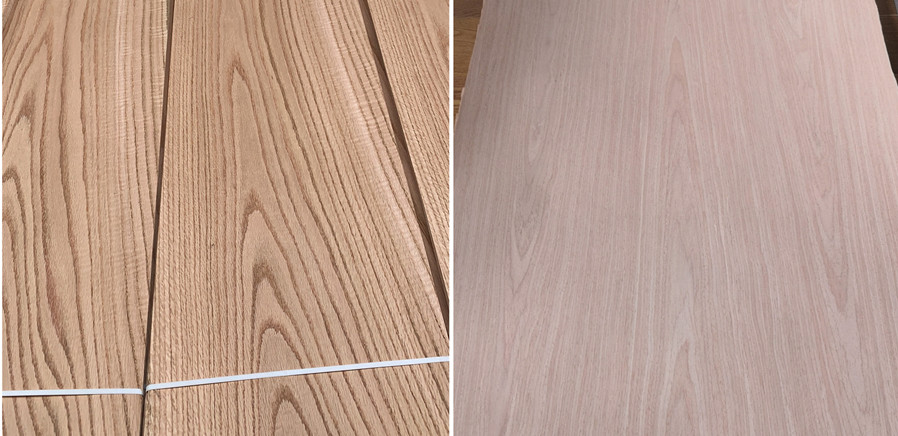
3.1 Natural American red oak wood veneer
Refer to the wood grains, there are about 4 different grains of natural American red oak veneer.
3.1.1 Crown cut grain red oak veneer
Crown cut grain, also known as flat cut, which offers the most traditional red oak appearance.
If you’re looking for a unique grain pattern resembling a cathedral or flame shape, this is the ideal choice.
It’s also a great option if you’re seeking the most common red oak veneer for your project.
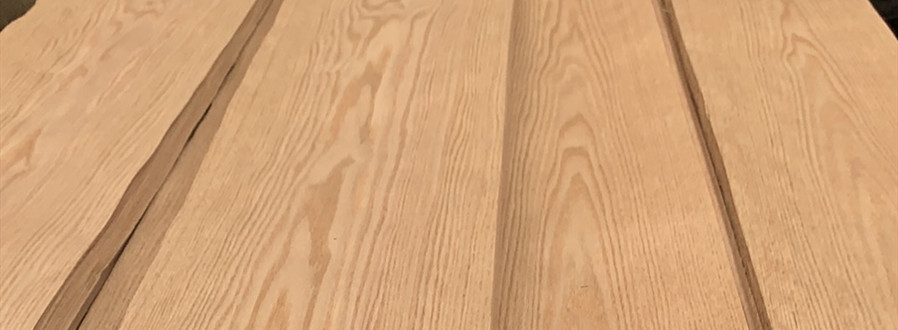
3.1.2 Rift cut grain red oak veneer
The rift-cut method produces an even grain and a distinct visual character, providing dimensional stability and a unique grain pattern.
The log is split into four pieces, each of which is cut vertically into boards.
Choose it if you want a highly stable and visually striking effect.

3.1.3 Half crown red oak veneer
Quarter cut and half crown cut look similar because the half crown is a variation of the crown cut.
It avoids defects in crown cuts, so you can still see subtle curved grain patterns in half-crown cuts.
And the half crown cut grain red oak veneer is most popular for random matching veneer layon.

3.1.4 Figured red oak veneer
For light and shadow effects in wood grain, red oak figured grain is the perfect choice.
Its unique fiber and growth ring patterns create striking visual beauty, enhanced by cutting techniques and the tree’s natural growth.

Besides the wood grains, you can also find many different types of natural American red oak veneer as below.
3.1.5 Different thickness of red oak wood veneer
0.4mm and 0.5mm thick veneers are commonly used in applications that require a lightweight, cost-effective material with the appearance and aesthetic appeal of solid wood.
They are ideal for decorative surfaces, cabinetry, and furniture where a natural wood finish is desired without the expense and weight of solid wood.
1mm,2mm,3mm, and 5mm thick red oak veneers are the best for decorative or light-duty use, while thicker ones (3mm, 5mm) provide added strength and durability for furniture, cabinetry, and architectural woodwork.
The choice depends on your aesthetic and durability needs.
3.1.6 Fleece/Paper backed red oak veneer
Super thin red oak veneer refers to ultra-thin slices of red oak wood, typically ranging from 0.18mm to 0.25mm in thickness.
These thin veneers are created by slicing red oak logs using specialized machines to produce veneers that are lightweight, flexible, and cost-effective, while still maintaining the natural look and aesthetic appeal of solid red oak.
Generally, Supper thin red oak veneer is not used alone, and needs to be pasted with backing material.
0.2-0.24mm or 0.4-0.5mm super thin red oak veneer can be pasted.
Fleece-backed oak veneer has a non woven fabric layer for added flexibility, strength, and stability, making it easier to install and more durable.
Ideal for profiles, doors, and furniture, it offers flexibility, durability, good light transmission, and is cost-effective and environmentally friendly.
Paper-backed red oak veneer features a thin oak layer on a flexible kraft paper backing, providing stability and ease of use.
Ideal for furniture, cabinetry, and interiors, it resists warping and simplifies application, making it a cost-effective choice.

3.1.7 Other special red oak wood veneers
3.1.7.1 Spliced American red oak veneer sheets
If the veneer size is insufficient during production, spliced red oak veneer is a great solution.
It offers high material efficiency and cost-effectiveness, and can also be customized with different grain patterns.
3.1.7.2 Woven red oak veneer sheets
Woven red oak veneer features interwoven strips, creating a textured, fabric-like surface.
It highlights red oak’s natural beauty with a modern touch, ideal for furniture and wall panels, while offering a luxurious look with improved material efficiency.
3.1.7.3 Smoked red oak veneer sheets
For a deeper, more complex tone with a warm finish, smoked red oak veneer is an ideal choice.
The smoking process imparts a unique aged look, enhancing the wood’s natural warmth and depth while reducing the need for staining.
It also evens out color variations, providing a consistent surface that’s perfect for large-scale applications.
It should be noted that people often call it fumed red oak veneer.
3.1.7.4 Dyed red oak wood veneer
For a different color, consider dyed red oak veneer, which is treated with stain to achieve a uniform tone or enhance the wood’s natural color.
Tabu from Italy is a leading supplier, while Chinese dyed veneer offers competitive prices.
3.1.7.5 Rought sawn cut American red oak veneer
Rough-sawn cut red oak veneer preserves the wood’s natural texture and grain, creating a rugged, organic look.
Ideal for rustic and industrial designs, it’s great for furniture, decor, and accents.
Though requiring careful handling, its unique aesthetic and durability make it a popular choice for unrefined, charming designs.
3.1.7.6 Cross cut end grain red oak veneer
End grain red oak veneer showcases cross-sections of logs, creating a unique, rugged look with visible growth rings and pores.
It offers durability and a striking aesthetic, making it popular for high-end, custom projects.
3.1.7.7 Red oak veneer rolls for edgebanding and profile wrapping
Red oak veneer rolls are thin sheets of red oak veneer that are rolled up for easy storage, handling, and transportation.
This format makes them particularly convenient for large-scale projects, allowing for flexible application on various substrates such as MDF, red oak ply, and chipboard.
Choose finger-jointed red oak veneer for superior strength and enhanced stability.
It resists warping and cracking, is eco-friendly by using smaller wood pieces, and offers a durable, attractive finish with seamless interlocking joints.
It is the best option for edge banding and moulding profiles wrapping.
Edge Banding is a finishing technique used to cover the exposed edges of materials like red oak plywood, MDF, particleboard, or laminate with a strip of material, typically wood veneer, PVC, melamine, or wood laminate.
The purpose of edge banding is to provide a smooth, durable, and aesthetically pleasing finish to the edges of wood products and furniture.
It also helps protect the material from damage such as moisture absorption, wear, and scratches.
Edge Banding is essential for providing a polished, finished look to wood-based products while also offering functional protection.
It should be noted that the veneer used for edging is generally thicker
Profile wrapping is a process used in woodworking and manufacturing where a material (usually vinyl, laminate, paper, or wood veneer) is applied to the surface of profiles (shaped edges or components) using a wrapping machine.
The material is tightly adhered to the profile’s surface, ensuring a smooth and durable finish.
Profile wrapping is generally used for curved surfaces.
To ensure flexibility, thinner veneers are generally used.
3.1.7.8 Matched red oak veneer layons
Matched red oak veneer layons refer to sheets of oak veneer that have been carefully selected and arranged to create a continuous, uniform grain pattern across a surface.
The veneer sheets are matched based on their grain direction, color, and texture to ensure a seamless and aesthetically pleasing finish.
Matched red oak veneer layons are ideal for creating a uniform, premium appearance in furniture and architectural designs, with consistent grain patterns that enhance the natural beauty of the wood.
Matched red oak veneer is roughly divided into book matched, slip matched, reverse slip matched, mismatched matched (Random matched), diamond matched, quarter matched, and herringbone matched.
3.2 Reconstituted Red Oak Veneer
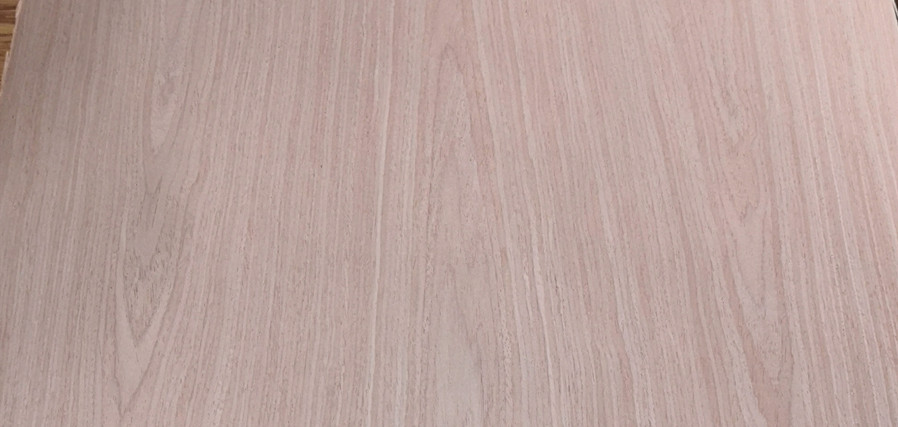
Reconstituted red oak veneer is also known as engineered red oak veneer and composite red oak veneer.
Its general production process is soaking, peeling, bleaching, dyeing, drying, repairing, gluing, pressing, making molds, and then slicing.
The raw materials of reconstituted red oak veneer are mainly divided into poplar, ayous, and basswood according to the quality from low to high.
The higher the quality of the raw materials, the higher the density of the Reconstituted red oak veneer produced.
Its thinnest thickness is 0.2mm, roughly 0.2-2mm, and the final processing degree is 5mm.
Its regular width is 640mm and 320mm, and other widths of veneer can also be customized.
Its regular length is 2.5m, and the length of some custom doors can reach 2.2m, 2.8m, or even 3m.
The texture and color of Reconstituted red oak veneer are uniform, and the texture is more consistent than that of natural red oak.
At the same time, it is made of wood fiber and by-products, so it is very environmentally friendly.
It also has an extraordinary price advantage because it is usually cheaper than solid red oak veneer, which can reduce manufacturing costs and waste. And it has a high density, which can save paint.
If you are looking for a more affordable and sustainable veneer, it is a good choice.
4. Advantages of using red oak veneer
3.1 Aesthetic Appeal
Red oak veneer has a distinctive, attractive grain pattern with a natural warmth and rich color that gives any furniture or surface an elegant look.
The wood’s reddish hue can add sophistication to any design.
3.2 Durability
Red oak is known for its strength and durability, making it a long-lasting choice for furniture, cabinetry, and interior wood doors.
The veneer retains much of the hardwood’s toughness while being lighter and easier to handle.
3.3 Versatility
It can be used in a wide range of design styles, from traditional to modern, due to its versatile look.
Red oak veneer works well with both matte and high-gloss finishes, providing flexibility in design.
3.4 Cost-Effective
Red oak veneer is more affordable than solid red oak, as it uses less material while still delivering the look and texture of real wood.
This can help reduce costs in large-scale projects without compromising on quality.
3.5 Environmental Impact
Veneer production allows the use of smaller trees or parts of trees that might not be suitable for solid lumber.
This makes it a more sustainable option compared to using solid hardwoods, helping to preserve forests.
5. Application of American red oak wood veneer
Red oak wood veneer is often attached to substrates such as plywood and MDF and then used in furniture making.
Tables & Chairs
Veneer red oak is applied to the surface of furniture pieces such as tables, chairs, and desks, providing the look of solid wood at a fraction of the cost and weight.
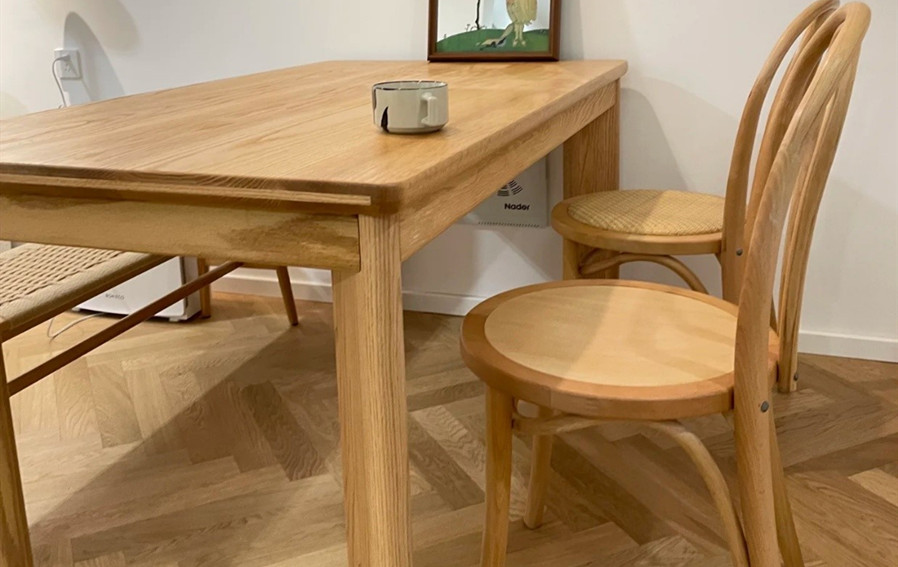
Cabinets
Red oak veneer is often used in cabinetry for both kitchens and bathrooms.
Its attractive grain pattern and warm tones make it ideal for traditional or contemporary cabinet designs.
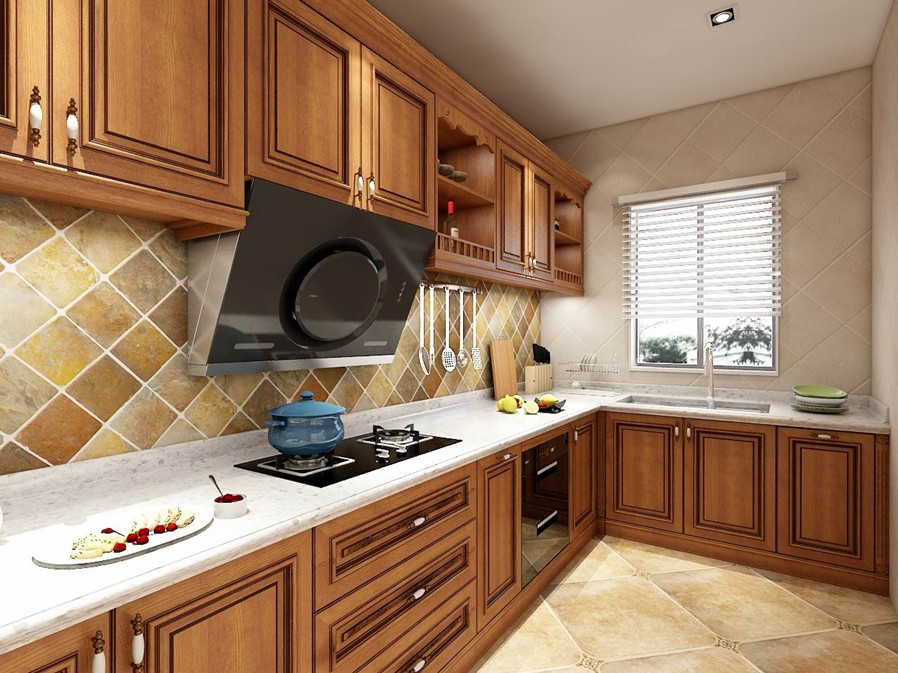
Shelvings
Red oak veneer can be applied to shelves or bookcases, allowing them to blend seamlessly with the rest of the decor.
Dressers
Veneered surfaces are perfect for dressers and nightstands, offering both elegance and durability without the expense of solid oak.
Doors
Red oak veneer is frequently used in both interior doors.
The most important application is door casing, which creates a rich and inviting look that suits many interior styles.
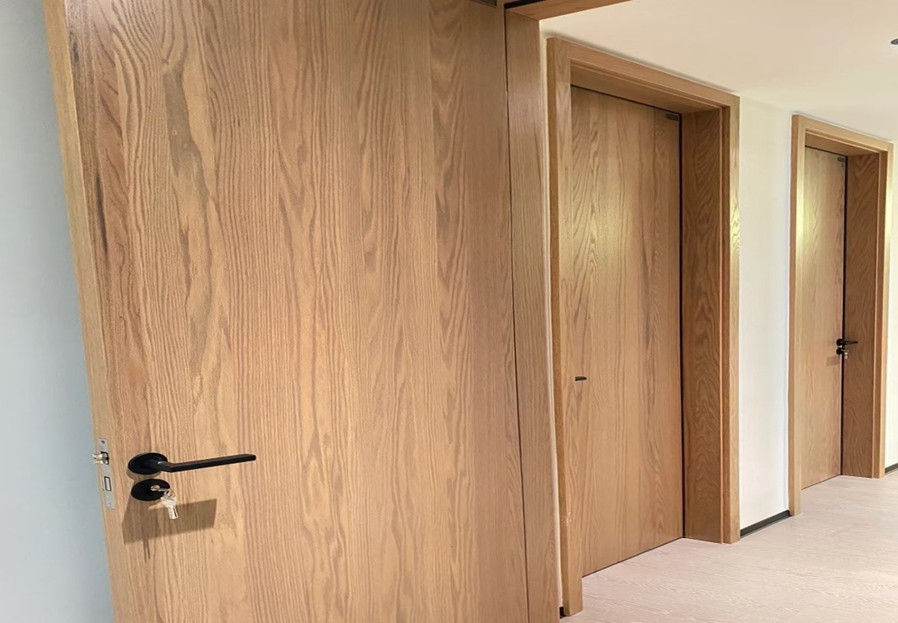
6. Red oak veneer in China
6.1 Exports of veneer red oak
In 2023, China’s red oak veneer production reached 350,000 tons, a 9.5% increase from the previous year.
Exports, mainly to Europe and the U.S., accounted for 45% of sales, totaling 1.162 million USD.
The main production areas are in the northeastern provinces and the Shandong Peninsula, producing over 70% of the total.
6.2 Demand for red oak veneer
Furniture manufacturing is the largest market for red oak veneer, representing 60% of demand, followed by flooring and decorative materials at 25%.
By 2025, red oak veneer is expected to make up 70% of the high-end custom furniture market.
E-commerce sales reached 20% of total sales in 2023, up from less than 5% five years ago, creating new opportunities for small and medium-sized businesses.
6.3 Price trends of red oak veneer
In 2023, the average ex-factory price of red oak veneer was 742 USD per ton, up 6% from the previous year due to rising raw material and labor costs.
Prices are expected to stabilize around 770 USD per ton by 2025 due to technological improvements.
The China-U.S. tariff trade war and a U.S. raw timber import ban in 2025 may lead to inventory shortages and price hikes from reduced supply and higher demand for alternatives.
Relevant data is obtained from Boyan Consulting & Market Research Online
7. Comprehensive problems in applying red oak veneer and solutions
7.1 Flake
Problem: Irregular striped grain patterns.
Solution:
✅ Change Cutting Method: Use a half rotary slicer to avoid tiger stripes and improve yield.
7.2 Veneer Curling
Problem: Warping or bending of veneer.
Solution:
✅ Acclimate the Veneer: Let it adjust for 24-48 hours to temperature and humidity.
✅ Proper Storage: Store flat in a dry, cool, stable environment, using protective covers.
7.3 Inconsistent Adhesion
Problem: Bubbles or lifting after installation.
Solution:
✅ Surface Preparation: Clean and sand surfaces to remove dust and contaminants.
✅ Correct Adhesive: Choose contact cement, wood glue, or polyurethane glue, and use water-resistant adhesive for high-moisture areas.
7.4 Veneer Cracking
Problem: Cracking or splitting during cutting or sanding.
Solution:
✅ Proper Moisture Content: Ensure appropriate moisture levels; lightly mist dry veneer for flexibility.
✅ Sharp Tools: Use sharp tools to avoid excess force.
Factors to consider when buying red oak veneer
8.1 Grade
Choose veneer based on grades (e.g., AAA, AA+, AA, A+) reflecting appearance and defects like Ambrosia wood, Crack, Ingrown bark, wood ray, sapwood, and knots. Consider sending a sample or visiting China for selection.
8.2 Color and Grain
Red oak veneer varies from light golden brown to reddish hues. For consistency, select sheets from the same batch.
It features various grain patterns like crown cut and quarter cut.
8.3 Backing Material
The backing affects durability, flexibility, and installation ease.
Common options include paper, fleece, MDF, veneer core, PVC, and phenolic resin backing.
Red Oak veneer offers both beauty and durability — a perfect combination for modern interiors and fine furniture.
If you’re looking for high-quality veneer solutions, feel free to contact us. We’re always happy to help you find the right match for your design and manufacturing needs.
Leave A Comment